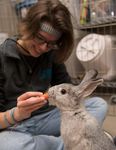Rescue Group Best Practices Guide - Animal Sheltering
←
→
Page content transcription
If your browser does not render page correctly, please read the page content below
This publication (Rescue Group Best Practices Guide) is intended to provide
general information about rescue best practices. The information contained in this
publication is not legal advice and cannot replace the advice of qualified legal
counsel licensed in your state. The Humane Society of the United States does not
warrant that the information contained in this publication is complete, accurate
or up to date and does not assume and hereby disclaims any liability to any person
for any loss or damage caused by errors, inaccuracies or omissions.CONTENTS
ACKNOWLEDGEMENTS ....................................................................................................5
INTRODUCTION................................................................................................................7
SECTION 1 | ORGANIZATIONAL STANDARDS
CREATING YOUR MISSION AND VISION............................................................................9
INCORPORATING AND APPLYING FOR
501(C)(3) TAX-EXEMPT STATUS......................................................................................9
FORMING YOUR TEAM......................................................................................................9
Building a Board of Directors.................................................................................................................................. 10
Building Your Staff..................................................................................................................................................... 11
Building a Volunteer Network................................................................................................................................. 14
OBTAINING INSURANCE..................................................................................................15
CREATING A BUDGET AND BUSINESS PLAN...................................................................16
FUNDING YOUR ORGANIZATION....................................................................................16
Types of Funds to Have............................................................................................................................................ 16
General fund........................................................................................................................................................... 16
Spay/neuter and general veterinary expenses................................................................................................ 16
Specific medical cases.......................................................................................................................................... 16
Creating a Development Plan.................................................................................................................................. 16
Marketing and branding....................................................................................................................................... 17
Fundraising............................................................................................................................................................. 17
Grant writing.......................................................................................................................................................... 17
Cost containment.................................................................................................................................................. 18
IMPLEMENTING A CULTURE OF RESPECT.......................................................................18
Engaging in Humane Discourse.............................................................................................................................. 18
Preventing Compassion Fatigue............................................................................................................................. 18
Customer Service Skills............................................................................................................................................ 19
SECTION 2 | ANIMAL CARE STANDARDS
THE FIVE FREEDOMS......................................................................................................21
STANDARDS FOR PRIMARY ENCLOSURES......................................................................21CONTENTS
PHYSICAL WELL-BEING...................................................................................................24
Vaccinations and Parasite Control......................................................................................................................... 24
Disease Prevention.................................................................................................................................................... 24
Spay/Neuter................................................................................................................................................................. 25
Microchipping............................................................................................................................................................. 25
Food.............................................................................................................................................................................. 25
Working with a Veterinarian.................................................................................................................................... 25
MENTAL WELL-BEING.....................................................................................................26
Stress........................................................................................................................................................................... 26
Fear Free..................................................................................................................................................................... 26
Enrichment................................................................................................................................................................. 26
Easy automatics..................................................................................................................................................... 26
Win-wins................................................................................................................................................................. 27
In-cage enrichment............................................................................................................................................... 27
Out-of-cage enrichment...................................................................................................................................... 27
Other stress relievers........................................................................................................................................... 28
Socialization............................................................................................................................................................... 28
VETERINARY POLICY.......................................................................................................29
EUTHANASIA POLICY......................................................................................................29
SECTION 3 | OPERATIONAL STANDARDS
RECORD-KEEPING...........................................................................................................31
TRANSPARENCY..............................................................................................................31
DETERMINING CAPACITY................................................................................................32
EXCEEDING CAPACITY....................................................................................................33
ANIMAL INTAKE..............................................................................................................34
Sources of Animals.................................................................................................................................................... 35
Creating a Plan............................................................................................................................................................ 35
Partner with a Local Shelter.................................................................................................................................... 36
Pet Retention Strategies .......................................................................................................................................... 37
Owner Surrenders..................................................................................................................................................... 38CONTENTS
Strays....................................................................................................................................................................... 38
Temporarily Holding an Animal.......................................................................................................................... 38
Use of Boarding Facilities.................................................................................................................................... 39
Transporting Pets.................................................................................................................................................. 39
SHELTER-TYPE FACILITIES..............................................................................................39
PROGRESSIVE ADOPTIONS.............................................................................................40
Process.................................................................................................................................................................... 40
Setting Your Adopters Up for Success............................................................................................................. 42
Events and Other Advertising............................................................................................................................. 42
FOSTER HOMES..............................................................................................................43
DISASTER PREPAREDNESS.............................................................................................43
SECTION 4 | COMMUNITY BUILDING
WITH OTHER ANIMAL WELFARE ADVOCATES................................................................45
Potential Partners to Increase Lifesaving Efforts............................................................................................... 45
Building a Transfer Program with Local Shelters................................................................................................ 45
Building a Transfer Program with Out-of-State Rescues................................................................................... 46
Building Coalitions..................................................................................................................................................... 46
WITH YOUR SUPPORTERS............................................................................................. 47
Website........................................................................................................................................................................ 47
Social Media................................................................................................................................................................ 48
APPENDIX
(These documents can be found at humanepro.org/rescuebestpractices)
A. SAMPLE BUSINESS PLAN
B. SAMPLE BUDGET
C. SAMPLE EUTHANASIA POLICY
D. SAMPLE INTAKE PLAN
E. SAMPLE PET RELINQUISHMENT
F. SAMPLE TEMPORARY PET RELINQUISHMENTAcknowledgements
The Humane Society of the United States thanks everyone who families whenever it’s possible, and to support homeless pets when
provided their wisdom and insights to make this publication as useful it’s not.
as possible to the rescue community, including PetSmart Charities,
whose grant funding made the original (2015) publication of this ABOUT THE HUMANE SOCIETY OF THE UNITED STATES
guide possible; Abby Volin, who wrote that original version; and to ev-
The Humane Society of the United States is the nation’s most effec-
eryone who reviewed it: Todd Cramer, Amber Sitko, Jan Elster, Kaylee
tive animal protection organization. Established in 1954, the HSUS
Hawkins, Stacy Smith, Kathy Gilmour, Mandi Wyman, Whitney Horne,
seeks a humane and sustainable world for all animals—a world that
Britney Wallesch, Carie Broecker, Laura Pople and Jme Thomas.
will also benefit people. The HSUS is America’s mainstream force
We would also like to acknowledge contributions from current and
against cruelty, abuse and neglect, as well as the most trusted voice
former HSUS staff: Betsy McFarland, Inga Fricke, Natalie DiGiacomo,
extolling the human-animal bond. The HSUS works to reduce suffer-
Sarah Barnett, Hilary Hager, Kathleen Summers, Joyce Friedman,
ing and to create meaningful social change by advocating for sensible
Lindsay Hamrick, Danielle Bays, Darci Adams, Windi Wodjak, Anne
public policies, investigating cruelty, enforcing existing laws, sharing
Marie McPartlin, Dr. Melissa Beyer, Vicki Stevens and Kelly Williams.
information with the public about animal issues, joining with corpo-
rations on behalf of animal-friendly policies and conducting hands-on
Last but not least, we extend our gratitude to all the rescue groups programs that make ours a more humane world.
whose staff and volunteers work so hard to keep pets with their
Rescue Group Best Practices Guide 5Introduction
Rescue groups are vital in the world of animal welfare and are them to help rescues operate at their maximum potential. This guide
collectively responsible for saving hundreds of thousands of animals can be used to evaluate the health of established organizations and to
every year. Some shelter animals, such as neonatal kittens or those help new groups get off to a successful start.
with medical or behavioral challenges, may be difficult for shelters
to place into homes. Rescue groups have resources to help these While there is no one-size-fits-all way to run a rescue group, there are
animals, making the groups' partnerships with shelters invaluable. standards—both from an organizational and an animal care stand-
They are incredible, lifesaving organizations. But what does it mean point—that all rescue organizations should meet. Above all, rescuers
to be a rescue? Does it simply refer to an organization that takes in owe it to the animals in their care to run their rescue operations in
homeless animals and finds them homes? Does it mean being part the most professional, collaborative and humane manner possible.
of an organization with 501(c)(3) nonprofit status? Does it mean
the rescue provides trap-neuter-return services to community cats? Ultimately, as rescue groups adhere to best practices, they
Actually, a rescue can meet all or none of these criteria. become more efficient and effective. This allows rescuers not only to
humanely take in and adopt out more animals, but also to build trust
This manual was designed to provide structure and guidance to all within the community; support pet owners so they can keep their be-
types of rescue groups. It describes best practices for these organi- loved pets, work successfully with local animal welfare advocates; and
zations and, perhaps more importantly, suggests ways to implement help solve the problem of pet homelessness on a community level.
Rescue Group Best Practices Guide 7Organizational standards
Rescue organizations should be run just like any other business. With many grants that are awarded only to nonprofit organizations. Non-
a solid foundation in place, you will have more support to grow profits can also apply for a mailing permit that gives them a special
your rescue group, allowing you to bring in more animals and save reduced rate for mailings.
more lives.
HOW: Check your state’s requirements for incorporating a non-
CREATING YOUR MISSION AND VISION profit with your state’s corporate filing office (usually called the
If you are thinking about starting a new rescue group, define your department of state, secretary of state or something similar) and
mission and vision before you do any other planning. Where is the investigate other resources. Contact the state office responsible
greatest need in your community? What do you hope to accomplish, for businesses to find out what your state’s specific requirements
and why? Conducting a community assessment can assist you in de- are or check out the comprehensive state-specific resources. Many
termining the type of help the animals in your community need. offices will provide a packet of information on how to incorporate,
along with sample documents. You will also need to draft articles
Typically, forming a rescue group consists of creating an organization of incorporation and bylaws in conjunction with incorporating your
that takes in animals who have been transferred from a shelter, relin- organization; these serve as the primary rules governing the manage-
quished by their owner or found as a stray; fosters them in a home ment of your corporation. Even if your state does not require bylaws
environment; and adopts them out. as a matter of law, it is still a good idea to draft them because they
define your business structure and specify how your organization will
There are other ways to help. Consider the needs in your community conduct its affairs.
before deciding what type of rescue group you want to start. If the
market is already saturated with traditional, adoption-based rescues, You can find samples for drafting articles of incorporation by search-
you may want to think about creating a prevention-based organiza- ing for state-specific samples on your state’s government website.
tion that keeps pets in their homes and stops them from entering the When you are ready to apply for tax-exempt status, all the informa-
shelter and rescue system in the first place. Your organization can sit tion you need is on the IRS website. Keep in mind that it can take
at the bottom of a broken dam, holding buckets to lessen the deluge many months to obtain 501(c)(3) status, so do not get discouraged.
of rushing water, or you can start from the top and plug the holes to Moreover, you may want to consult with an attorney or accountant
prevent the water from leaking in the first place. Prevention-based who specializes in nonprofits, even if it’s just to have them review the
organizations might focus on low-cost spay/ neuter, trap-neuter-re- completed application.
turn for community cats, lost-and-found, behavior assistance, legal
assistance, pet food pantry operation or other valuable programs. Also remember to check whether your state has specific licensing
requirements, if any, for operating a shelter or rescue group. You
INCORPORATING AND APPLYING FOR 501(C)(3) can usually find any laws pertaining to animals in your state’s agricul-
TAX-EXEMPT STATUS ture code.
WHY: Incorporating as a business in your state is an easy way to
FORMING YOUR TEAM
show the world that your rescue group is a legitimate business ven-
ture and that you are treating it as such. Further, the corporate for- Every rescue group needs three layers of support to build a full
mation protects individuals in the organization from legal liability and team. At the top is the board of directors. These are the members
debt incurred by the rescue group. More importantly, your organi- who oversee the strategic direction, or long-term planning, of an
zation has a significantly better chance of being approved for 501(c) organization. The next layer consists of staff, including an executive
(3) tax-exempt status if you incorporate. And having that tax-exempt director, who run the day-to-day operations of the rescue group.
status is crucial for your organization’s ability to grow. Not only is Some rescue organizations are able to pay a few staff members, but
the organization exempt from federal income tax, but you can entice generally these groups rely on volunteers. It is still important to call
donors with a tax deduction for their contributions and apply for the these dedicated members “staff” regardless of whether they are
Rescue Group Best Practices Guide 9ORGANIZATIONAL STANDARDS
paid, because it demonstrates that your organization is run profes- of the rescue group (unless the organization has a “working board,”
sionally. Doing so also gives individuals a sense of ownership, respon- where board members double as staff), but instead are involved in
sibility and appreciation for the hours they contribute. The final layer strategic planning. That is, how will the organization get from where
of your team is the volunteers—people who help out on a regular it is today to where it wants to be in a few years? The board of direc-
basis by supporting the staff. Whether they foster animals, assist at tors is a group that advances the organization’s mission by providing
adoption events, transport animals to veterinary appointments or advice, money, time and expertise. A sample strategic plan devised
participate in countless other activities, volunteers are the lifeblood and implemented by a board of directors may be helpful.
of any rescue group.
Generally, board members on working boards are expected to be
BUILDING A BOARD OF DIRECTORS heavily involved in strategic planning, fundraising and policy decisions
Every organization has a board of directors, which is a body of elect- for the organization. When forming your board, think about the type
ed or appointed members who oversee the activities of the corpora- of people who are going to help fulfill the organization’s mission and
tion. Their responsibilities are detailed in the organization’s bylaws, goals: Someone with fundraising abilities? Public relations or market-
but typically, members of the board are responsible for governing ing savvy? Legal or accounting abilities? Management background?
the organization, appointing and reviewing the executive director, Political connections? Choosing friends and family to serve on your
approving budgets, approving an organization’s policies and other board may be necessary at first, but once you become established
similar tasks. Board members have an obligation of allegiance, care you will want to be more strategic in selecting board members. An
and duty to the organization. For rescue groups, it is important to independent board is important for your organization’s credibility.
recruit people who will help the organization fulfill its mission state- Having family members on the board could be viewed negatively, so
ment by providing advice and implementing long-term goals that it is an important point to consider.
will help the organization plan for the future and create the vision of
what it will become. Check the laws in your state to determine the exact number of
people you need on a board, but at a minimum you will need to have
Board members are not the ones who run the day-to-day aspects a president, a secretary and a treasurer. The executive director is not
Rescue Group Best Practices Guide 10ORGANIZATIONAL STANDARDS
normally a board member, but is instead accountable to the board adoption coordinator. Do not be afraid to move people around and
of directors and also serves as the bridge between the board and try them in different roles until you have the right fit. Even though
the staff who carry out the day-to-day functions of the organization. it can be difficult to leave a crucial position empty until you find the
Board members will need to be willing to commit their time and perfect match, in the long run your organization will be much better
resources to the organization. You may want to implement term off having the right people in place.
limits for members of the board or have nonvoting members who
are there exclusively in an advisory role. It is helpful to have a job Below is a basic template to use in building your rescue group’s staff,
description so that prospective members will know what will be including suggestions for job responsibilities and helpful skills. This
expected of them. list is not meant to be all inclusive, so use it as a starting point and
tweak it to fit the needs of your organization. And do not be afraid
Importantly, the board of directors is responsible for approving new to split these positions among several people—there is plenty of
contracts (such as foster agreements or adoption contracts) and work to go around! Just remember that you do not need to fill all
authorizing certain individuals (usually the executive director, the these positions immediately. Start small and continue to build as
board president and the board vice president) to sign documents on your rescue group gains more volunteers. Once your rescue group
the organization’s behalf. You may also want the board to authorize is established, it is certainly appropriate to pay staff according to the
specific individuals to sign agreements relevant to their area of ex- laws of your state. Organizations that have paid staff find that it leads
pertise. For example, the board might allow the adoption coordinator to less turnover and more consistent policies and procedures.
to sign adoption contracts or authorize the volunteer coordinator to
sign volunteer agreements. EXECUTIVE DIRECTOR This person is the face of your organization
and chosen by the board of directors. In addition to being the rescue
In keeping with good practices and to build a trustworthy organiza- group’s spokesperson, this individual is responsible for the day-to-
tion, it is important for the board to create well-documented polices day operations of the organization and interacts with the board of di-
that foster transparency. For example, it is essential to have a conflict rectors as well as other staff members and volunteers. The executive
of interest policy for the board of directors, a document retention director ensures that the organization is operating according to its
policy, a code of ethics, a harassment policy, a whistleblower policy mission statement and developing funds and policies for its future.
and, if applicable, written compensation practices. The individual in this position should have business and media savvy
as well as a considerable amount of patience and tact.
A strong board of directors is vital to the current success and future
development of your rescue group. Pick your board members RECORDS MANAGER An obsessively organized and detail-oriented
thoughtfully! volunteer should fill this post. This individual should be tech savvy as
she will be dealing with paperwork and animal management soft-
BUILDING YOUR STAFF ware. The records manager will update each animal’s profile with
current location, medical history and outcome, and she’ll update
While the board of directors is accountable for the long-term goals
bios and pictures for the group’s website and other listings. As your
of the organization, the staff is responsible for running the day-to-
organization grows and the number of animals coming in and out on
day operations of the rescue group. After you have filed the articles
a weekly basis increases, this becomes one of the most overwhelm-
of incorporation and applied to the IRS for tax-exempt status, the
ing jobs. Find a couple of people to share the work or rotate the
next important task is developing your team. Although the majority
responsibilities every few months.
of your staff will be unpaid volunteers with other jobs and obliga-
tions, it is crucial that all individuals involved are committed to their
FINANCIAL COORDINATOR Do you know someone who is an
positions to ensure that the rescue runs as smoothly as possible.
accountant or math whiz? This person might be a good candidate to
keep track of the organization’s finances, both outgoing expenses
Do not put someone into a role simply because they offered or be-
and incoming donations. When it comes time to file your 990 tax re-
cause you are eager to fill the position. The person’s skills must align
turns with the IRS, this person will prepare the information for your
with the post. For example, the outgoing individual who loves meet-
group’s accountant. If someone in your rescue group or community
ing new people but has never balanced a checkbook would better
is an accountant, ask if she will donate her services come tax time. If
serve the organization as a volunteer coordinator than the financial
you do not have this type of contact, seek help from a professional.
coordinator. Similarly, the individual who does not bat an eyelash
If your rescue group has its 501(c)(3) status, you can inquire about
at mounds of paperwork, yet gets easily stressed by demanding
receiving a reduced rate.
customers, might be a great fit for the records manager but not the
Rescue Group Best Practices Guide 11ORGANIZATIONAL STANDARDS
CORPORATE RELATIONS COORDINATOR You need someone program designed to keep foster providers learning and engaged. It
who can reach out to corporations—such as pet stores or big-box is essential to build good relationships with foster providers to keep
chains—and other service providers to negotiate prices for food, them happy and willing to continue fostering! It is also a good idea
veterinary services, transport and other items so your rescue can to have this person implement a support network (such as a listserv
minimize expenses. or a group on social media) that enables foster providers to connect
with each other.
FACILITY DIRECTOR Are you going to have a brick-and-mortar
facility to house some or all of your animals? Or even a few cages ADOPTIONS COORDINATOR/COUNSELOR The adoptions coordi-
in a storefront? If so, you will need someone to run each facility. nator position is great for someone who has reasonable email access
Ideally, this person will live close to the facility because he will have throughout the day and time to field the many inquiries she is likely
to be at the location on a frequent basis, including during emergency to receive. You want someone who would not feel compelled to use
situations. The facility director will create protocols to care for the rigid rules for adoptions but instead would use general guidelines
animals and ensure their well-being, as well as train, schedule and as set by the board of directors and is comfortable communicat-
supervise volunteers. This position is ideal for someone with com- ing with potential adopters to support the adoption process. This
munity outreach experience who can turn a job cleaning cages into is another position that requires considerable tact, sensitivity and
a fun task in which volunteers feel invested. Good people skills are thoughtfulness. This post is a good fit for someone who is a “people
also a must as this person will be the face of the organization at that person” and understands that customer service is critical to adop-
facility. It is critical to have someone on staff who knows how to han- tion success.
dle unvaccinated animals and animals who may have been exposed to
diseases in the community like parvovirus and panleukopenia. They ADOPTION EVENT COORDINATOR Who likes to get up early
must also have an in-depth understanding of effective cleaning and during the weekend? Grab this person to be the event coordinator
sanitation protocols, and they should be familiar with the Association and have him plan and run weekly adoption events. Responsibilities
of Shelter Veterinarians’ Guidelines for Standards of Care in Animal include showing up every week to set up and break down the event,
Shelters (which outlines best practices for running an animal facility) having the appropriate paperwork on hand and projecting a warm
and understand how to implement these standards. When setting up and welcoming appearance to all potential adopters and foster pro-
your own facility, be sure to look into local kennel or zoning ordi- viders who pass by.
nances at the outset. Many other issues will have to be considered as
well, such as how to fund the facility and deal with challenges such as VOLUNTEER COORDINATOR It is a good idea to have a volun-
neighbors who may oppose your group’s presence. teer coordinator on board to manage the various volunteer needs
throughout the organization. This person will take all volunteer
FOSTER COORDINATOR This position requires someone with a lot inquiries and direct them to the appropriate staff member, as well
of patience and good people skills. The foster coordinator needs to as handle volunteer orientation and training sessions. This person
give prospective foster providers a clear list of what the group will should be comfortable using social media and other methods to
provide and what the foster provider will be responsible for when actively recruit volunteers when needed. Because the volunteer
caring for animals. Importantly, this person needs to be constant- coordinator is also responsible for troubleshooting volunteer issues
ly accessible via email and phone to respond to foster providers’ and potentially terminating volunteers who do not work out, choose
questions in a timely manner. Additionally, the foster coordinator someone who is just as comfortable having difficult conversations as
will coordinate returns and find a new foster homes for pets when she is engaging and motivating volunteers. It is also important
necessary. This post might also start a continuing education for the volunteer coordinator to have a general idea of the needs
within each area of the organization so she can create or modify
shifts when there is an imbalance. For example, if one facility has
50 volunteers to fill 14 shifts, but another location has only 10, the
volunteer coordinator can request that some people move to the
Having a photographer on staff (either a volunteer at your second location. Because this person will have contact information
organization or someone in your community willing to do- for all volunteers in the group, she will be a good resource when
nate time) is key. A good picture can make all the difference other immediate needs arise, such as when an animal needs trans-
in getting an animal adopted. Watch How to Photograph port to a new home or to the veterinarian. This is also the go-to
Shelter Pets for some great pro tips! person to coordinate with any outside group, such as a local school
or business, that wants to partner to provide volunteers for a day.
Rescue Group Best Practices Guide 12ORGANIZATIONAL STANDARDS
MEDICAL COORDINATOR This person is responsible for schedul- BEHAVIOR AND TRAINING SPECIALIST This person (whether on
ing veterinary appointments and working as a liaison between the staff or not) will assist animals in your rescue with enrichment, train-
rescue group and any veterinarians the organization works with. It is ing and addressing behavior issues, as well as pets and pet owners
confusing and wasteful to allow everyone from the rescue to contact struggling with behavior problems at home (as a means of surren-
the veterinarian when an animal has a medical issue. It will make der prevention). The individual should have experience in humane
everyone’s life easier if only one or two people from a rescue group training techniques that use positive reinforcement. It is helpful to
are allowed to approve veterinarian appointments. Putting approved have standard operating procedures already drafted for common be-
veterinarian services in writing and faxing/emailing the authorization havior issues that could occur with your rescue animals. The person
to the veterinarian before an appointment can reduce confusion and in this position should work closely with the volunteer, foster and
make the experience better for foster providers and veterinarians. adoption coordinators to help prevent problems before they start.
Many veterinarians appreciate the clarity this process provides, and it Reaching out to local dog training facilities is an option as well; many
can also make it easier to cross-reference invoices with billing state- trainers will be happy to provide ongoing training for fosters. Check
ments down the line. The only caution is that the medical coordina- out Fetching the Perfect Dog Trainer by Katenna Jones for advice on
tor should have constant access to email and phone, otherwise there finding a dog trainer who uses positive reinforcement training meth-
may be problems scheduling and approving emergency appoint- ods. The HSUS’s Guide to Cat Behavior Counseling and the related
ments. Because medical situations can be unexpected and urgent, online course are also great resources.
it is crucial to identify someone as the backup for this position. The
medical coordinator should have a general knowledge of common COMMUNICATIONS/MARKETING/PUBLICITY SPECIALIST
animal health problems so he can readily determine when it is nec- Someone with excellent communication skills, social media savvy
essary for an animal to see the veterinarian. This person should also and web design experience is perfect for this job. This is also a great
establish protocols for certain situations. For example, if there is an opportunity for someone who enjoys planning fundraising events
emergency and a foster parent takes his foster animal to the veteri- or someone who wants to help but is not able to volunteer on a
narian without getting prior approval from the medical coordinator, regular basis. Be careful in your choice—whoever represents you on
who would be responsible for the bill? social media will be considered the face of your organization. If you
Rescue Group Best Practices Guide 13ORGANIZATIONAL STANDARDS
would not trust the person to give an interview to the media, she is owners, your rescue group, veterinary, behavioral and other service
probably not the best person to manage your organization’s online providers, other local animal organizations—to ensure pets in your
presence. You will also want a backup administrator, someone else community have access to all available resources needed to thrive
who has access to your social media channels, in case you lose the with their families. This individual will conduct ongoing outreach to
main volunteer. pet owners in your focus communities, connecting them with spay/
neuter, vaccination and other veterinary/behavior/wellness resources
GRANT WRITING COORDINATOR Notice the word “coordinator” for their pets when requested by community members. They may
on this one. It is not reasonable to expect one person to write all the also assist with transporting pets to and from spay/neuter or other
grant proposals for your rescue, but it is helpful to have someone veterinary appointments, and follow up with clients via phone and
who can search through the resources to find applicable grants and home visits as needed to support the family and their pet(s). Further,
form a team of people to draft the proposals. The coordinator keeps this person will assist in planning, organizing, advertising and imple-
track of grant applications in progress, proposal deadlines, proposal menting community outreach events, as well as collect data neces-
specifications and eventual outcomes. sary for ensuring your program is meeting its objectives and focusing
resources in areas with the highest need.
FUNDRAISING EVENTS COORDINATOR A fundraising team is nec-
essary to help offset the organization’s expenses. Tasked with leading There are countless other positions your organization can create
your rescue’s fundraising efforts, the individual in this position to make the rescue group run smoothly. Think about the goals and
should have experience in event planning and should organize several needs of your organization and plan accordingly. And remember,
different types of events throughout the year. nothing is set in stone—you have the flexibility to adjust positions
and responsibilities to make them work for you. Once you have your
COMMUNITY OUTREACH ORGANIZER team in place, create an organizational chart so that it is clear to
This person will build long-term relationships with community all staff and volunteers who is in charge of each area within your
members as a representative of your rescue group and so must be rescue group.
personable, engaging and have excellent customer service skills.
Ideally, the candidate originates from the communities being served BUILDING A VOLUNTEER NETWORK
and/or is fluent in community language(s). The primary purpose of Volunteers are a crucial part of any rescue group—you cannot run an
this role is to build trusting relationships among stakeholders—pet organization without them. From taking care of animals to running
Rescue Group Best Practices Guide 14ORGANIZATIONAL STANDARDS
adoption events, from transporting animals to creating pet bios and and share a success story along with pictures. Seeing happy pets
taking pictures, there are countless opportunities for volunteers to in their new homes or learning that 20 animals were adopted in
help your rescue. Having a structured program in place is essential to one weekend is often the most fulfilling part of volunteering for a
recruiting and retaining volunteers. Providing training, guidelines and rescue group.
support for volunteers will help prevent frequent turnover.
As volunteers get more engaged, they may also want to try new
In creating your volunteer program, think about your organization’s things. Take their offers of help seriously and, if possible, give them
specific needs and the characteristics of your ideal volunteer. Then room to try new things that could benefit your group. Sometimes
ask for just that in your position description. Also think about what their suggestions might not be feasible. If this is the case, do not
the volunteers are going to get out of the experience. When crafting simply say “no,” but explain the reasoning and offer alternatives. This
a position description, consider elements such as the purpose of the increases their buy-in and interest in the group, and it can help retain
job, work involved, training required, learning opportunities offered, those who are truly interested in helping long-term.
commitment needed, level of difficulty involved, skills necessary and
type of environment expected. You should also consider listing the For more information, check out the HSUS's resources on
physical, mental and emotional requirements. At the same time, do staff/volunteer management.
not make your program so rigid and demanding that it discourages
or excludes people who want to volunteer on a somewhat limited OBTAINING INSURANCE
basis. Make room for everyone.
Every rescue group should carry insurance to protect the organiza-
tion, its individual board and staff members and its volunteers.
Communication is essential when it comes to running a successful
volunteer program. What are your expectations of volunteers, and
General liability insurance is important to carry; it will cover claims
how can they provide feedback to you? Asking for a minimum time
for bodily injury or property damage to people not associated with
commitment (three months is usually a good length of time) pro-
your organization. This ensures that your organization is covered if,
vides consistency for everyone involved and gives the volunteer an
depending on the policy, a customer slips on a wet floor during an
out if the experience ends up not being right for them.
adoption event, a volunteer transporting a pet to her new home has
a car accident and injures the other driver, or a cat bites a potential
It is important to hold an orientation and training session before
adopter. Additionally, you need to purchase workers' compensation
you allow volunteers to roll up their sleeves and dig in. Try to hold
if your organization has paid staff, and possibly property insurance if
orientations and trainings on a regular basis so that you do not lose
your rescue has its own facility. You can also buy insurance to cover
someone interested in volunteering because the next orientation is
medical costs for volunteers and fosters who are injured while per-
too far in the future. The orientation should provide an overview of
forming tasks for your organization.
the organization, details about what is expected of volunteers and
additional information that will help people decide whether or not to
Although forming a corporate entity protects individuals from per-
participate. The training session should cover all relevant rules, pol-
sonal liability for any corporate wrongdoing, directors and officers
icies and procedures, as well as detailed information people need to
of a board can still be personally sued for reasons such as misuse of
accomplish their specific tasks. Handing out a volunteer manual that
company funds, fraud, violating the law, gross negligence and neglect
summarizes everything you went over in the orientation and training
of legal and financial duties. As such, it is a good idea to purchase di-
is a good practice. You should also create “how-to” guidelines for
rector and officer (often called “D&O”) liability insurance to protect
every task volunteers are asked to do at your rescue. Even better,
corporate directors and officers in the event of a lawsuit. This type
supplement the manual with pictures, and keep it easily accessible.
This will help volunteers and create consistency within the organi-
zation. The training session is also a good opportunity to collect a
liability waiver from all volunteers (you should also obtain liability It is important to work with trainers and behavior
insurance, which is discussed in the next section). If you hold events experts, but they are not always easy to find. The
at pet stores and other locations that you do not own, make sure you following resources may be helpful in finding a good
check for any age requirements before accepting volunteers under partner for your organization:
18 years old. ɠ apdt.com ɠ ccpdt.org
ɠ m.iaabc.org ɠ dacvb.org
Do not forget to show your volunteers the fruits of their labor. Let
people know on a regular basis which animals have been adopted,
Rescue Group Best Practices Guide 15ORGANIZATIONAL STANDARDS
of insurance usually covers legal fees, settlements and other costs. donated funds are spent. It is helpful to have several funds to which
Sometimes the D&O insurance will also protect a corporation if it is people can donate to help you care for the animals.
named as a defendant in a lawsuit.
ɠ GENERAL FUND The majority of your donations will fall into this
CREATING A BUDGET AND BUSINESS PLAN category, and any funds that are not otherwise earmarked will
As a tax-exempt organization, you are required to stay in good go here. You can use this money for anything needed to run your
standing with the IRS. This means annually filing a 990, 990-EZ or rescue, such as veterinarian bills, pet food, utility costs, animal
990-N tax return with the IRS, in addition to fulfilling any local and transport and staff salaries. Having a “donate here” button on
state requirements. Engaging in good accounting practices from the your webpage or social media accounts will help with fundraising
beginning will help you stay organized and focused. An essential step for general funds.
toward this goal is creating a budget for your organization. Develop- ɠ SPAY/NEUTER AND GENERAL VETERINARY EXPENSES You
ing a budget will require you to thoughtfully estimate costs for the will always need more funding for spay/neuter as well as veteri-
year for items such as food, veterinary care and insurance, and it will nary care. Make it easy for people to donate to those causes
help you plan fundraising events to support your efforts. by letting them know that you are trying to build funds in
these areas.
Running a rescue is a legitimate nonprofit endeavor and should be
treated as such to ensure that the organization will be there for the ɠ SPECIFIC MEDICAL CASES Promoting specific animals with spe-
long haul. Creating a business plan will help you think about building cial needs is a great way to pay for unusually expensive cases. Be
a sustainable future for your rescue group by outlining your mission, careful to ensure that all funds designated for a particular animal
forecasting budgets, making priorities and setting strategic goals. are used for that animal only. All extra funds must be returned
You may want to consult a financial adviser to get started on the to donors and not used for other animals. Make sure you are
right foot. From the beginning, you need to think about where you upfront and clear to potential donors about where and how the
want your organization to be in six months, one year and five years funds will be spent so they do not feel misled.
down the road. Think of the business plan as a roadmap to keeping
the organization on track, achieving your goals and fulfilling your CREATING A DEVELOPMENT PLAN
mission. Strategically planning for your rescue group will help ensure Do not rely on adoption fees as your sole source of income. Between
that your organization is around to help animals for many years spay/neuter, vaccinations and veterinary fees, many times the adop-
to come. tion fee will not even cover the amount of money you have to spend
on an animal before he can be adopted. While adoption fees are a
You can find a sample business plan in Appendix A and a sample bud- way to defray some of these costs, you will need to develop a plan
get in Appendix B, available at humanepro.org/rescuebestpractices. that brings money into your organization on an ongoing basis.
FUNDING YOUR ORGANIZATION A rescue group based in Arlington, Virginia, exemplifies how an
organization can diversify its funding base. While some of its
Funding a rescue organization requires some basic business skills in
revenue comes from adoption fees, the bulk comes from
marketing, fundraising, grant writing and cost containment. Plan to
donations, fundraising events and partnerships with its for-profit
set aside $5,000 to $10,000 for startup costs for your rescue group.
subsidiary businesses—two pet boutiques and a full-service pet care
This should cover startup items such as food, bowls, toys, blankets,
company. An organization in Chicago, Illinois, uses the proceeds from
cages, carriers, collars, leashes, litter boxes, litter and veterinary
its boarding and training center to fund the nonprofit rescue group.
funds for your first few charges. Even if you run a foster-based orga-
While these specific models may not be feasible for your organiza-
nization and ask foster providers to cover the daily cost of food, it is
tion, the lesson is clear: Diversify your funding base, and do not count
a good idea to have backup items on hand.
on adoption fees to cover all your costs.
Once your organization is established, it is important to have a
Creating a development plan will provide a path for your organization
reliable and constant source of income. Without a solid plan in place,
to grow and focus on long-term goals. It will also enable you to deter-
your rescue group will not be sustainable.
mine which fundraising efforts work and where you should concen-
trate your energy. Importantly, it will help ensure your organization is
TYPES OF FUNDS TO HAVE
there for the long haul.
Good accounting practices require that you keep track of how
Rescue Group Best Practices Guide 16ORGANIZATIONAL STANDARDS
MARKETING AND BRANDING Marketing and branding are essen- in more funds to your organization, as well as planning and running
tial for highlighting your organization and attracting more donors, fundraising events.
volunteers and adopters. Do not be intimidated; marketing is simply
using strategies and tactics that help you build relationships with There are a whole host of ways you can fundraise for your organi-
supporters and fulfill your mission. Creating a marketing plan on an zation: Cultivate donors, establish membership tiers, offer animal
annual basis is an effective tool to help you achieve your goals as it sponsorships, create “in honor of” and “in memoriam” funds, sell
creates a unified vision for everyone in the organization and guides plaques for adoption event cages, post a wish list, develop a planned
decisions about resource allocation. giving program, encourage in-kind donations, pursue corporate
sponsorships, send direct mailings, plan fun and creative events—the
There are numerous ways to market your organization. Start a list is endless.
newsletter or fundraising appeal letter (either printed or electronic)
highlighting all the wonderful animals your organization has rescued. When planning an event, consider how many volunteers you will
People are more likely to give when they are proactively asked to need, how much time it will take to plan, how you can advertise the
donate. There are simple and inexpensive programs available to help event, how much money you can spend on the event, how much
you create a newsletter without the help of a graphic designer. And money you plan to raise from the event and how you can measure
remember, people want to hear about the great work your group success. Note that it is not always about how much money you
does for animals. You are the voice for the animals in your care, so raise—sometimes the exposure you gain is even more valuable.
tell their stories.
Many times, all you need to do to secure a donation is ask—so do
Another way to advertise your rescue group is to start a branding not be shy! A rescue group in New York City once reached out to a
campaign—create a logo and put it on T-shirts, bags and other items cat litter company requesting a donation for the nonprofit organiza-
to sell. There are numerous companies that will do this for your orga- tion. The company’s response? It sent 180 eight-pound bags of litter
nization at little or no cost. Once you do create a logo and finalize at no cost.
your organization’s name, protect your brand by purchasing all web-
site domains with that name (including both .org and .com suffixes), This brings up another important point: Do not forget about in-kind
apply for a copyright for your name and apply for a trademark for donations, which are contributions of goods or services. Many orga-
your logo. You can find information on how to apply on the United nizations prefer to contribute in-kind donations, which can be just as
States Patent and Trademark Office’s website. It is possible to fill out valuable as cash donations.
the applications yourself, but you may want to hire an attorney to
ensure it is done properly. Send thank-you emails for every donation, whether cash or in-kind,
and reserve thank-you letters in the mail for larger donations. It is
FUNDRAISING Fundraising efforts need to be given the same, if crucial to include specific information in thank-you notes so that
not more, attention as your efforts to save animals’ lives. In general, donors can receive tax deductions for their contributions.
if your organization is unable to raise sufficient funds to pay for its
work, it is unlikely that you will be able to raise those funds at a later GRANT WRITING This is another area where you should build a
time. More importantly, attempting to raise funds after you have dedicated team. Recruit people who are highly organized, know the
obligated your rescue group to specific projects is not a sustainable organization well and are good writers. The grant writing process
way to run your organization and makes it unlikely that the group will is not as overwhelming as people often fear, and once your writers
last for long. have a couple of proposals under their belt, they will feel more con-
fident and comfortable with the process. The HSUS has a compre-
Fundraising activities are regulated by state law. The majority of hensive list of grants, and Candid, formerly The Foundation Center, is
states require nonprofits that solicit donations from within that state
to register with its governing body. Each state has different regis-
tration requirements, so make sure you have submitted the correct
paperwork and registered in every state where you are soliciting Always send a thank-you note to your donors, even if they
donations. You may want to consult an attorney familiar with fund- only give a small amount. People appreciate the personal
raising regulations to ensure full compliance. contact, and if you can give an example of how the funds
were used (e.g., picture of a dog toy or cat bed) it helps
Fundraising should not be the responsibility of just one person. cement the connection.
Create a committee charged with developing creative ways to bring
Rescue Group Best Practices Guide 17You can also read



























































